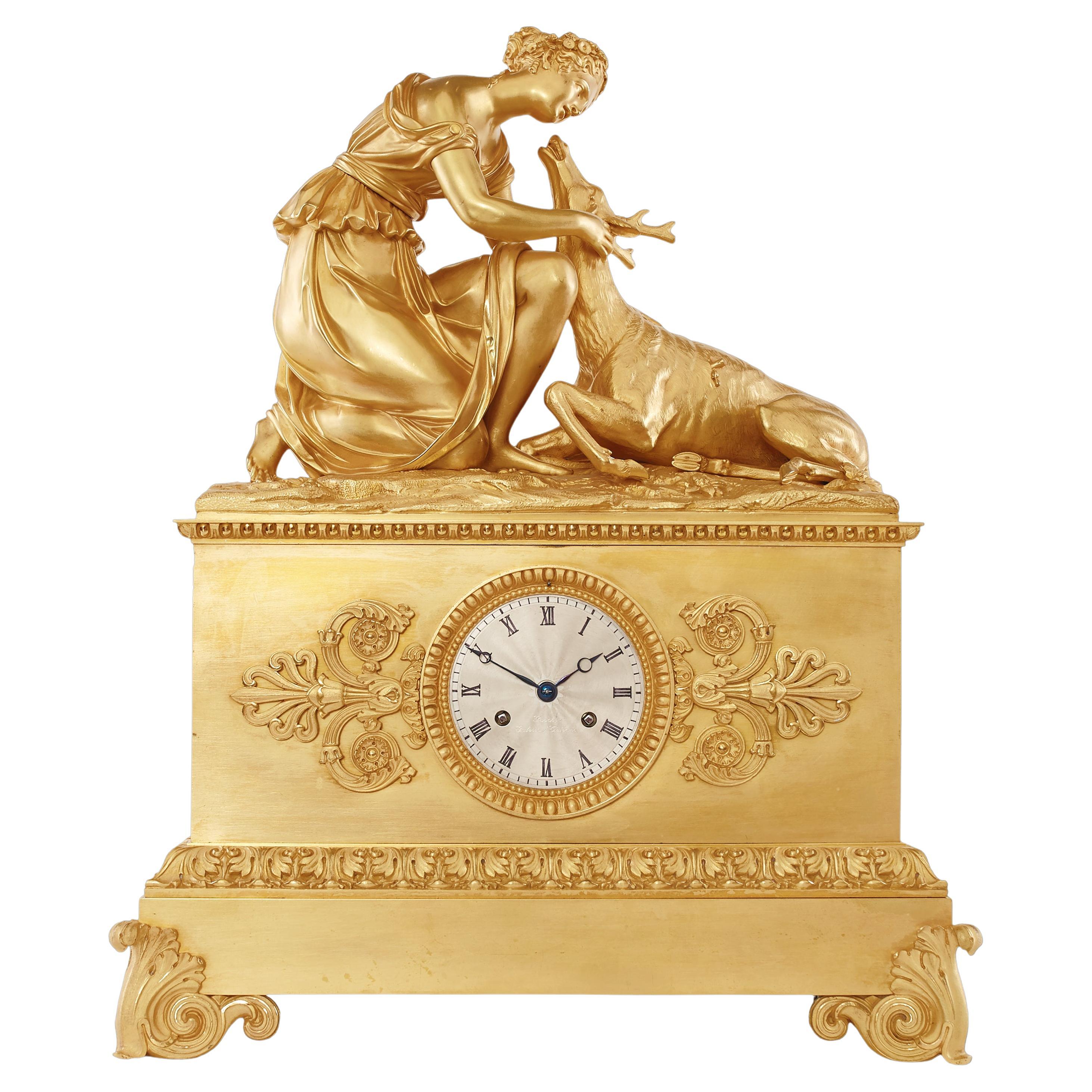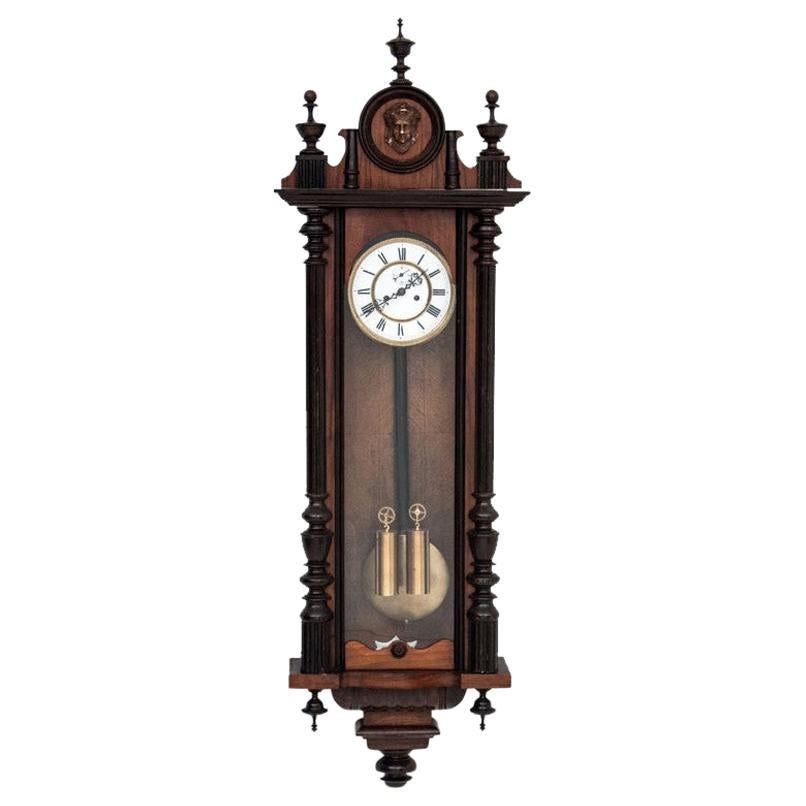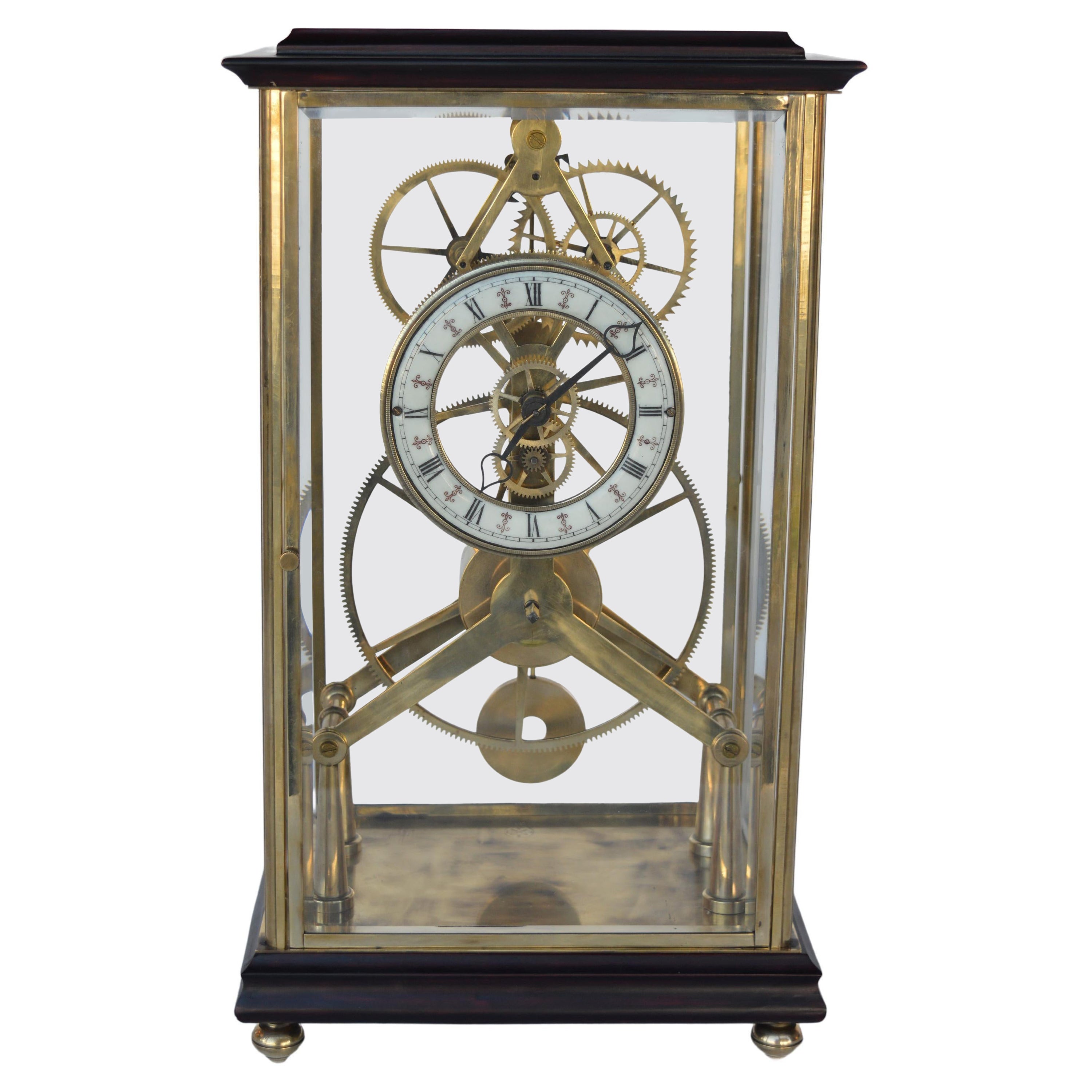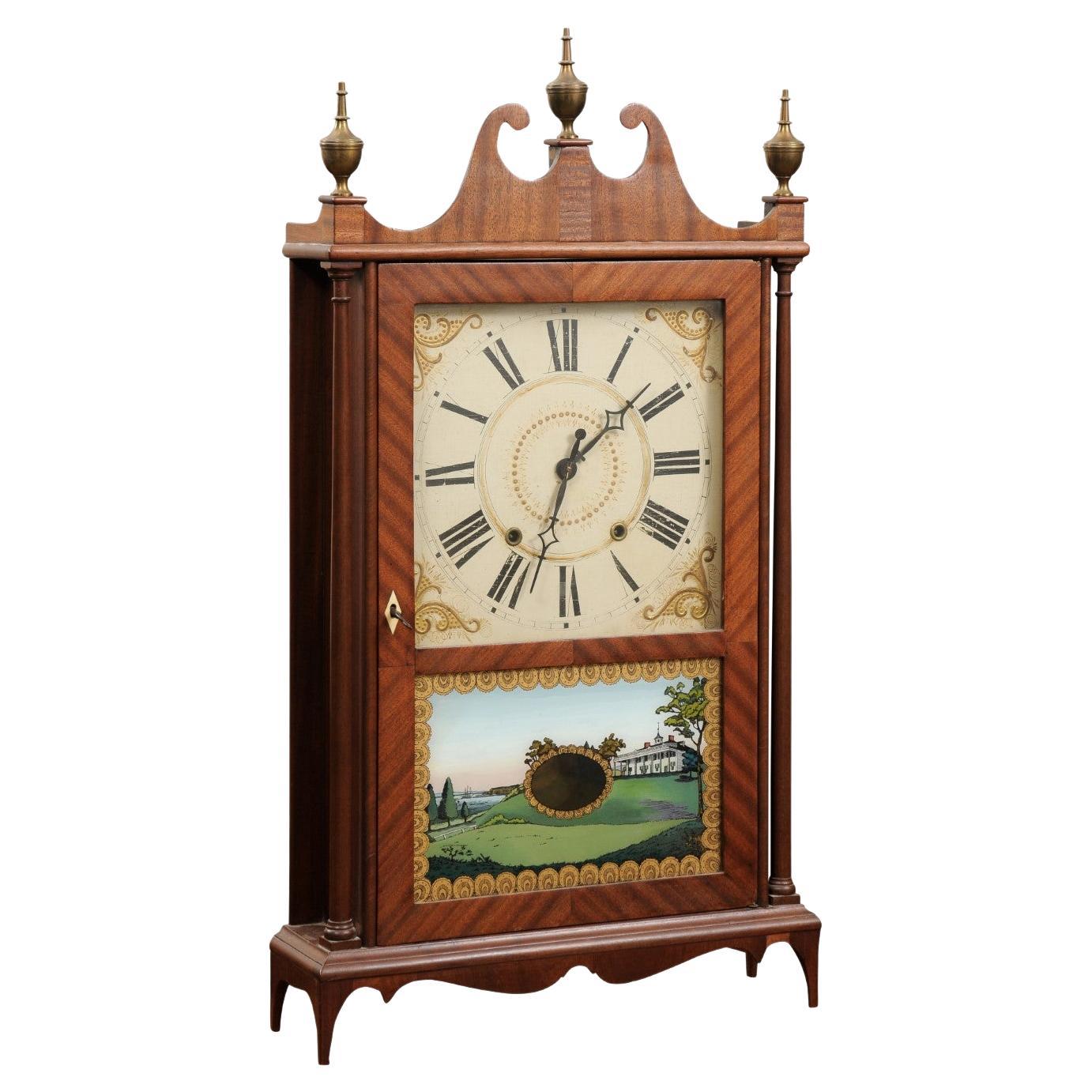Items Similar to Late Edo Period 19th Century Japanese Pillar Clock, Shaku-Dokei, C. 1820
Want more images or videos?
Request additional images or videos from the seller
1 of 5
Late Edo Period 19th Century Japanese Pillar Clock, Shaku-Dokei, C. 1820
About the Item
Elegant Japanese pillar clock, 'SHAKU-DOKEI', c. 1820
The very fine 30-hour, weight-driven movement is constructed between bars and consists of a going train only. It has verge escapement with balance on top of the upper plate. Around the balance is a circular surround with an aperture. A small brass convex disc on the balance acts as a false 'pendulum'. It is driven by a lead weight which carries the hand. The skeletonised brass front is engraved with a chrysanthemum motif. Top and bottom plates are connected by four turned pillars.
The wooden dial - the pillar - has thirteen movable engraved brass hour chapters, called toki. The Japanese characters on the toki depict the following numbers from top to bottom: 6, 5, 4, 9, 8, 7, 6, 5, 4, 9, 8, 7, 6. The time is indicated by a pierced brass pointer which slides down the case trunk.
The movement is situated a shitan case, the hood being glazed on all sides so that the movement is entirely visible. To wind the clock, the hood can be removed by unlocking a wooden turnbuckle. The winding key is stored in a small drawer at the bottom of the pillar.
Height: 42 cm; width: 6cm; depth: 6cm.
Literature:
W. Brandes, Alte Japanische Uhren, München, 1976
N.H.N. Mody, Japanese Clocks, Rutland, 1977
E.L. Edwardes, Dutch Clocks & Their Japanese Connections, Ashbourne, 1996, pp.158 ff.
Note
Japanese time measurement is very different from its counterpart in the Western world. Instead of a fixed value for an hour the length of an hour in Japan, called toki is variable depending on the length of the day and night. Day and night are both divided into six toki, which lasts from sunrise to sunset and from sunset to sunrise. In summer the days are longer than the nights and consequently a day toki last longer than a night toki. In winter it is the other way around. This is the reason why Japanese clocks have sliding chapters to adjust the length of a toki. There are also clocks with a fixed chapter ring and a revolving hand. To regulate the lengths of the toki the weights on the foliot can be moved, which makes the clock go faster or slower. The hour numerals run from nine to four, the latter being midday. Japanese clocks indicate how many hours there are to come, whilst European clocks indicate how many hours have past. In Japan the figure 9 was holy. Each toki, twelve in total, also had its own sign of the zodiac, which were sometimes indicated on a ring around the chapter ring.
- Dimensions:Height: 16.54 in (42 cm)Width: 2.37 in (6 cm)Depth: 2.37 in (6 cm)
- Style:Edo (Of the Period)
- Materials and Techniques:
- Place of Origin:
- Period:
- Date of Manufacture:1820
- Condition:Wear consistent with age and use.
- Seller Location:Oxfordshire, GB
- Reference Number:1stDibs: LU4936225934952
About the Seller
5.0
Recognized Seller
These prestigious sellers are industry leaders and represent the highest echelon for item quality and design.
1stDibs seller since 2019
20 sales on 1stDibs
Typical response time: 1 hour
Associations
LAPADA - The Association of Arts & Antiques Dealers
- ShippingRetrieving quote...Ships From: Faringdon , United Kingdom
- Return PolicyA return for this item may be initiated within 14 days of delivery.
More From This SellerView All
- 19th Century French Flame Mahogany Napoleon Empire Period Mantel ClockBy Breguet a ParisLocated in Oxfordshire, United KingdomA superb 19th century French Flame Mahogany Napoleon Empire Period Egyptian style Mantel Clock This clock was produced in the Fr...Category
Antique 19th Century French Empire Mantel Clocks
MaterialsBrass
- Striking 19th Century Carriage Clock with a Gilt-Brass Corniche Case by GrohéLocated in Oxfordshire, United KingdomStriking carriage clock with a gilt-brass corniche case by Grohé, circa 1880. A most attractive eight-day striking carriage clock, signed on...Category
Antique 19th Century French Neoclassical Carriage Clocks and Travel Clocks
MaterialsBrass
- 19th Century Eight-Day Miniature Gilt-Brass Carriage Clock with Original CaseLocated in Oxfordshire, United KingdomA charming late 19th century French engraved miniature oval carriage clock with original travelling case. The petite miniature oval gilt brass ...Category
Antique 19th Century French Victorian Carriage Clocks and Travel Clocks
MaterialsBrass
- Fine 19th century French ormolu mantel clock (pendule) by Leroy a Paris, c. 1825By LeRoyLocated in Oxfordshire, United KingdomA most beautiful French ornolu mantel clock by Leroy à Paris A lovely French late Empire/early Charles X mantel clock with an ormolu case, c. 1825. The ormolu brass case depicts a celebration of Science and Learning. It is dominated by a rectangular superstructure containing the movement, flanked by an engine-turned column with a celestial globe on top on the left and an elegant lady reading a book on the right. The superstructure is surmounted by a bookcase and a bust of Socrates...Category
Antique Early 19th Century French Empire Mantel Clocks
MaterialsBrass, Ormolu
- 19th-Century Flame Mahogany Mantel Clock by Breguet Raised by Lion Paw FeetBy Breguet a ParisLocated in Oxfordshire, United KingdomAn extremely rare mantel clock with a figured mahogany-veneered case by A-L Breguet Abraham-Louis Breguet (1747-1823), who was of Swiss origin, is undoubtedly the most celebrated clockmaker of the late eighteenth and early nineteenth centuries in France. He is responsible for the invention of the self-winding watch, the tourbillon and the sympathetic watch ( a watch that is placed in a cradle of a special clock. It is then linked by means of a pin fixed behind the clock dial. Built into the motion work which, when released by the clock, automatically sets the hands to the clock's time as well as correcting the watch's regulator necessitated by any degree of inaccuracy registered at the moment of synchronisation) and many other horological improvements and developments. Around the year 1807 Breguet brought in his son, Antoine-Louis (born 1776), as a business partner, and from this point, the firm became known as Breguet et Fils. Breguet had previously sent his son to London to study with the great English chronometer maker John Arnold...Category
Antique Late 18th Century French Empire Mantel Clocks
MaterialsBrass
- Fine George III 18th Century Period Mahogany Longcase Clock by Tomas FowleLocated in Oxfordshire, United KingdomA fine George III period mahogany longcase clock of excellent colour, patination and proportions, circa 1780-1790 Surmounted with three ball and spike brass finials, the inverted ...Category
Antique Late 18th Century English Chippendale Grandfather Clocks and Lon...
MaterialsMahogany
You May Also Like
- Mantel Clock 19th Century Transitional PeriodLocated in Warsaw, PLThe clock is in excellent and perfect working condition. In addition, it has been cleaned and maintained by a professional watchmaker specializing in museum maintenance. The eight-da...Category
Antique Early 18th Century French Industrial Mantel Clocks
MaterialsBronze
- Antique Wall Clock, Late 19th CenturyLocated in Chorzów, PLThe clock is functional, after the clockmaster review Year: The end of the 19th century Origin: Western Europe Dimensions: Height 133 cm / width 42 cm / depth 17 cm.Category
Antique Late 19th Century Belgian Other Wall Clocks
MaterialsOak
- French Late 19th Century Skeleton ClockLocated in Los Angeles, CAStamped, French late 19th century skeleton clock. Made out of Mahogany wood and brass. Porcelain dial with roman numeral details.Category
Antique Late 19th Century French Table Clocks and Desk Clocks
MaterialsBrass
- Early 19th Century American Pillar & Scroll Clock in MahoganyLocated in Atlanta, GAEarly 19th Century American Pillar & Scroll Clock in Mahogany with Eglomise Painted Landscape SceneCategory
Antique 19th Century American Table Clocks and Desk Clocks
MaterialsMahogany
- Mantel Clock 19th Century Napoleon III PeriodLocated in Warsaw, PLMantel clock 19th century Napoleon III period.Category
Antique Mid-19th Century French Napoleon III Mantel Clocks
MaterialsLapis Lazuli, Malachite, Bronze
- Mantel Clock 19th Century, Napoleon III PeriodLocated in Warsaw, PLA beautiful clock made of bronze and malachite in an intense green and blue color. The clock stands on four decorated feet in the shape of paws. At the foot of the dial there is a cu...Category
Antique 19th Century French Napoleon III Mantel Clocks
MaterialsMalachite, Bronze





